When it comes to driving motivated traffic to your Shopify store, no other digital marketing strategy is as affordable or impactful as SEO.
For e-commerce retailers, taking the time to ensure your web pages are properly optimized can help increase your organic traffic, meaning more potential customers browsing your products.
Unlike Google Ads or social media advertising, SEO strategies can drive site traffic to your Shopify website long after your ad budget runs out.
For this reason, leveraging SEO is one of the best digital investments a Shopify site owner can make.
What Is Shopify SEO?
Shopify SEO is the process of optimizing a Shopify website to perform better in search engine results.
Although SEO can be applied to any website, Shopify SEO is focused on helping e-commerce retailers who utilize the Shopify CMS to earn more keyword rankings and organic traffic.
Common SEO Challenges For E-Commerce Websites
In general, e-commerce websites are more likely to face certain challenges that can negatively impact search engine performance.
- Thin Content: Google loves in-depth, long-form content. Because product pages tend toward thin content, it can be difficult to boost their rankings in search.
- Duplicate Content: With multiple product pages that are so similar or auto-generated, many e-commerce websites face duplicate content issues.
- Poor Site Architecture: Google likes to see an optimized site structure that users can easily navigate. With so many pages on their website, e-commerce retailers can easily suffer from poor site architecture signals.
- Not Utilizing Schema: Products schema helps Google crawlers understand your products and promote them accordingly. Not utilizing schema is a huge mistake for Shopify retailers.
To make sure that your website doesn’t suffer from these common setbacks faced by e-commerce sites, the Shopify SEO checklist below is a great place to start.
Automated SEO Features In Shopify
The Shopify platform does have some SEO features built-in that ease some of the SEO workload on-site owners.
These features include:
- Auto-generated “rel-canonical” tags: this feature helps avoid duplicate content penalties!
- Auto-generated robots.txt and sitemap.xml files.
- Automatic SSL certificates: Google prefers to rank secure pages with HTTPS protocols.
- Auto-generated page titles that include the store’s name.
However, SEO is a vast and multidisciplinary field.
Counting on the Shopify platform alone to do the work of SEO for you is not going to produce the best results.
19 Must-Do Tasks On Your Shopify SEO Checklist
Remember that SEO is not a one-and-done process and will require work both when you initially set up your store and throughout the lifetime of your website.
The checklist below is organized by the type of optimization, but it can be easily completed “in order.”
Some of these steps are a one-time optimization, but the majority will need to be repeated whenever you add new products or pages to your online store.
General SEO
1. Invest In A Custom Domain
It’s generally better to invest in a custom domain and drop the “myshopify” from your URLs.
Why? Because the URL path is visible to users at the top of the SERP result. Custom domains look more professional and more enticing to users, and higher CTRs lead to better SEO performance.
-
 Screenshot from Google Search, January 2022
Screenshot from Google Search, January 2022
You can buy custom domains from Shopify or any third-party domain provider.
Then, add your custom domain in the Settings > Domains menu of your Shopify account.
2. Choose A Fast And Responsive Theme
With last year’s page experience update, fast page speed and load times are non-negotiable if you want to rank well in Google.
Although flashier themes might be tempting, it is better to choose a theme that is optimized for speed and performance.
Your theme also needs to perform well on mobile devices, as Google will index the mobile versions of your web pages.
-
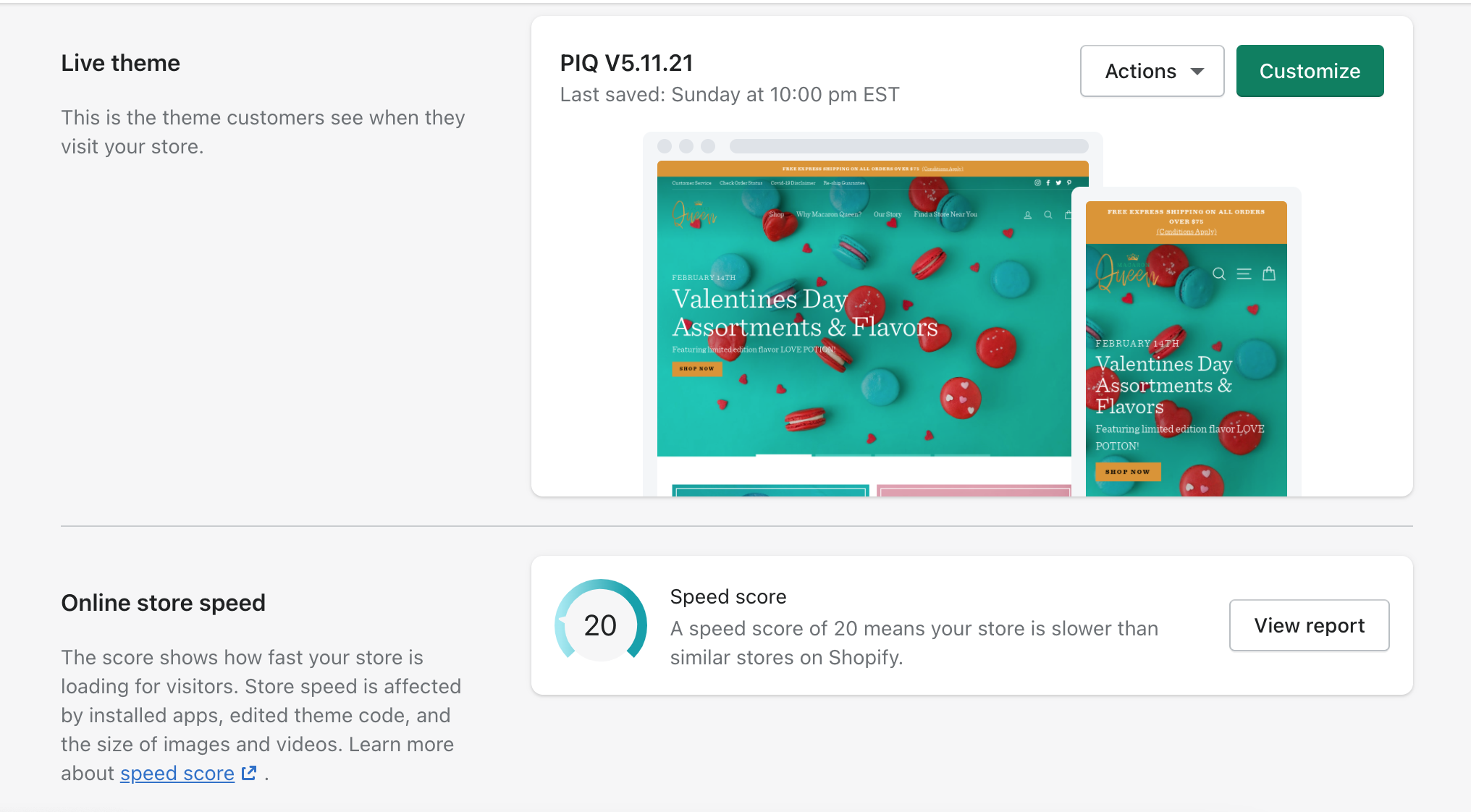 Screenshot from Shopify, January 2022
Screenshot from Shopify, January 2022
You can get a sense of how fast your current Shopify store is in comparison to others in your dashboard or via your PageSpeed Insights report. If your scores are low, it’s likely impacting your ability to rank in top positions.
Consider another, more SEO-friendly theme.
Here is a list of some of the fastest themes on Shopify.
3. Setup Your Analytics Tools
Your Shopify Analytics dashboard will give you an overview of your e-commerce metrics.
However, you need to set up additional tools to better understand where your website traffic comes from and how users behave once arriving at your website from search.
Google Analytics and Google Search Console are must-haves for any site owner, and they are completely free to users.
After you create your accounts, here are some other key steps you’ll want to take:
4. Get Helpful Shopify SEO Apps
There are all sorts of Shopify SEO apps that can help ensure you are meeting SEO best practices across your web pages. Some of my favorites include:
- Plug In SEO: Similar to Yoast SEO for WordPress and ensures best practices.
- SEO Pro: Great for schema and more advanced optimizations.
- Smart SEO: Very affordable option for lots of SEO value.
On-Page SEO
5. Do Your Keyword Research
Before you start optimizing your content, you need to identify which keywords have strong relevance to your products and will bring qualified traffic to your website.
There are hundreds to thousands of ways users might be searching for products like yours. A keyword tool allows you to discover what users are searching for.
-
 Screenshot from SearchAtlas, January 2022
Screenshot from SearchAtlas, January 2022
Some of those keywords will be easier to rank for than others, and a part of your SEO work is identifying which keywords present the best opportunities for your store.
The most important keyword metrics to pay attention to are:
- Search Volume: You want your keyword targets to get a reasonable number of searches per month, otherwise you’re optimizing for no one.
- CPC: Higher CPCs represent stronger conversion potential. Higher CPCs are more common with commercial and transactional keywords.
- Keyword Difficulty: Higher scores will mean the keywords are more difficult to rank for. Make sure you choose keyword targets where you can realistically rank on page 1.
Ideally, each web page in your Shopify store will be targeting a different keyword or keyword cluster.
For your product and category pages, optimize for keywords that show more transactional intent, as those users are more inclined to make a purchase.
For your blog posts, optimize for informational queries to capture searchers near the top of the funnel.
6. Optimize Your URLs
There are some URL best practices that are essential to improving your rankings in Google.
- Keep it short and sweet.
- Include your target keyword.
- Avoid unnecessary words like and/or/the/etc..
You can easily edit the URL paths in the Search Engine Listing Preview at the bottom of any page in the Shopify CMS.
-
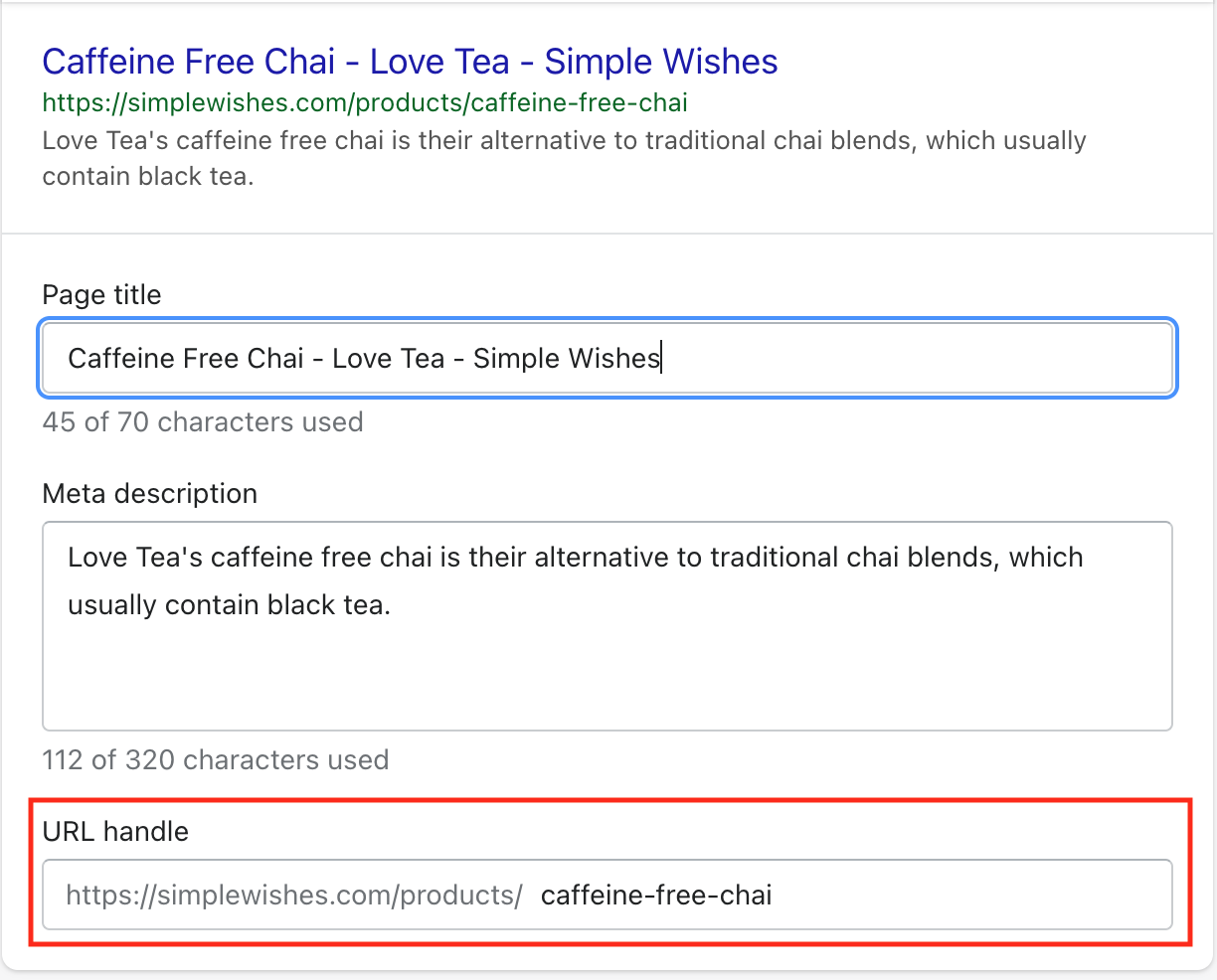 Screenshot from Shopify, January 2022
Screenshot from Shopify, January 2022
7. Optimize Your Page Titles And Meta Descriptions
While you’re editing your Search Engine Listing, make sure you also optimize the other meta tags visible in your SERP result: the title tag and meta description.
You’ll want to follow best practices here as well by including your keywords and meeting SEO best practices, especially length – no more than 60 characters for your title tag and no more than 160 for your meta description.
-
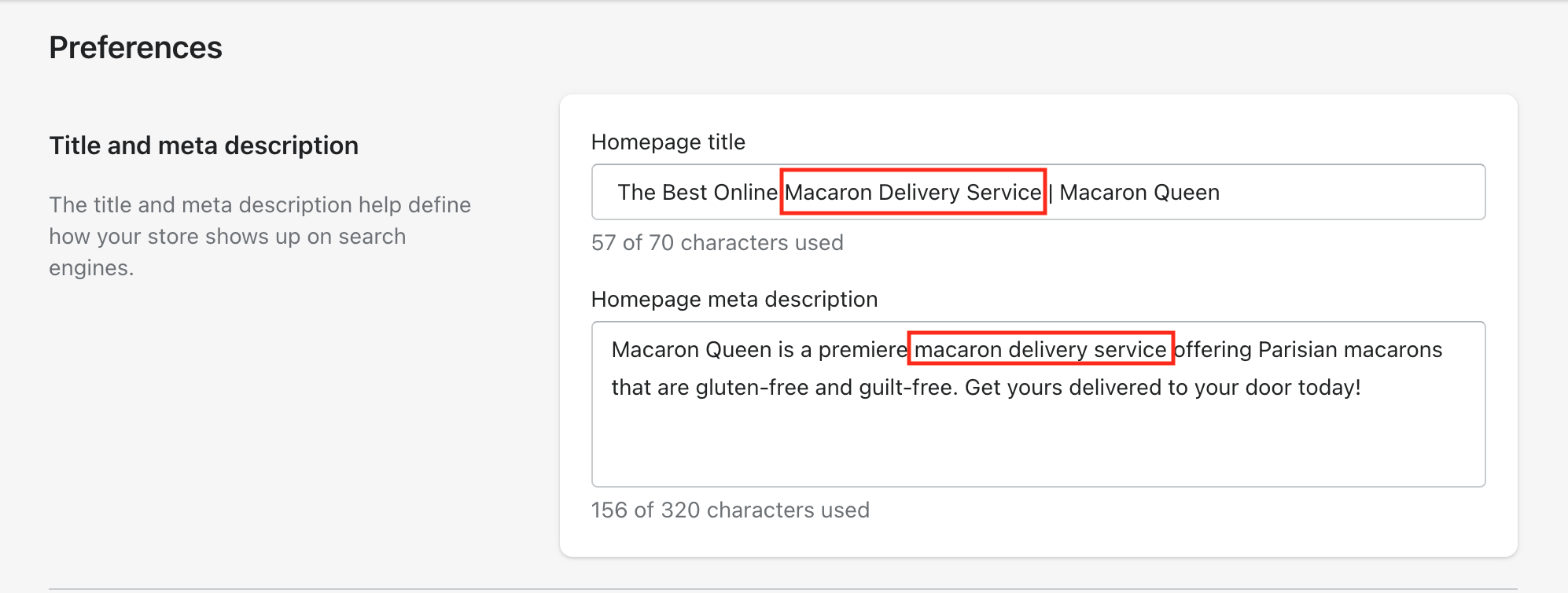 Screenshot from Shopify, January 2022
Screenshot from Shopify, January 2022
Google looks to these pieces of metadata to understand what your content is about and when to promote it.
And because the meta description may also be visible as a search snippet (although not always), it can influence whether searchers click on your result.
Google is smart enough to understand the terms and phrases that have a semantic relationship to your primary keyword, so there is no need to stuff these on-page elements with the same keyword over and over again.
Your meta tags should read naturally and adequately describe the content on the page.
8. Use A Content Optimization Tool For Your Product Descriptions
Thin content on product pages can be a serious hindrance for e-commerce websites.
Make sure you take the time to craft original, descriptive product descriptions that include relevant keywords, synonyms, and related terms.
-
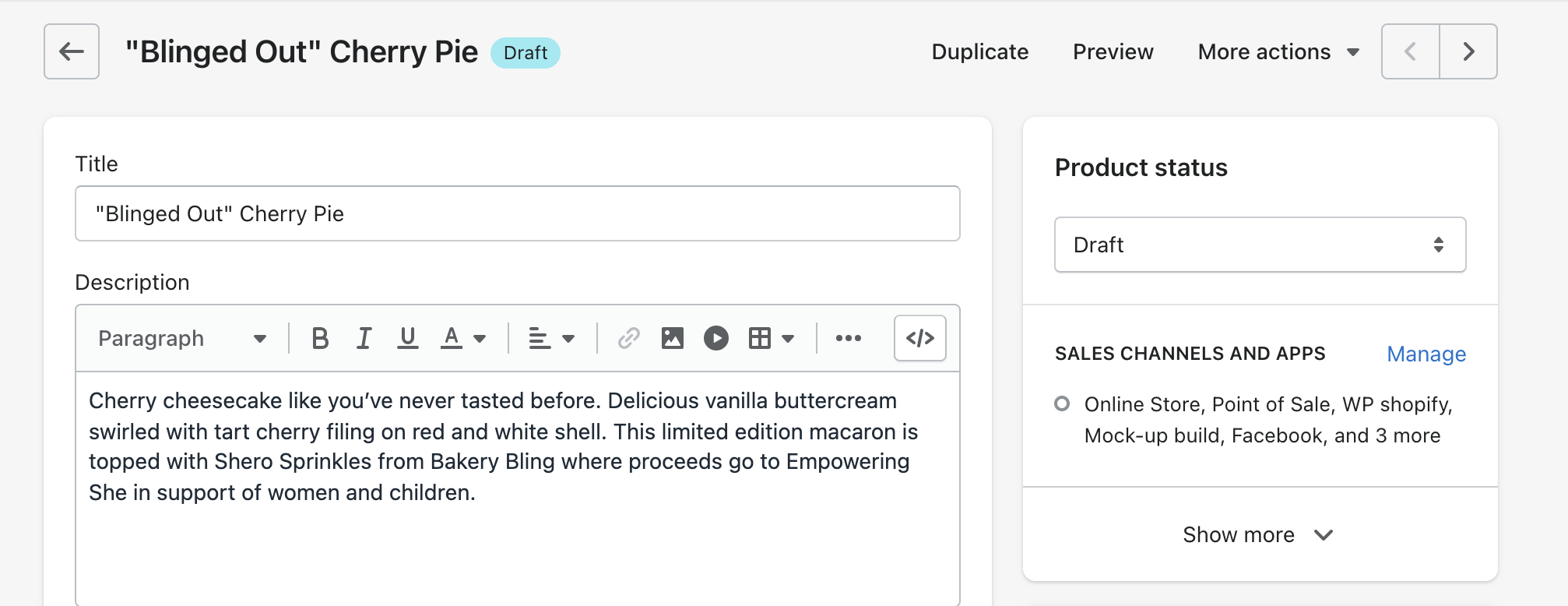 Screenshot from Shopify, January 2022
Screenshot from Shopify, January 2022
-
 Screenshot from the SEO Content Assistant, January 2022
Screenshot from the SEO Content Assistant, January 2022
A content optimizer tool can help you identify which related keywords have the most SEO power and show strong relevance signals to your products.
Do your best to include them in a natural way to elevate the ranking potential of your product pages.
9. Optimize Your Alt Text
Your Shopify website likely has lots of images that showcase your products.
But remember, Google cannot see your images. It’s important you communicate to Google what those images are through descriptive file names and keyword-rich alt text.
-
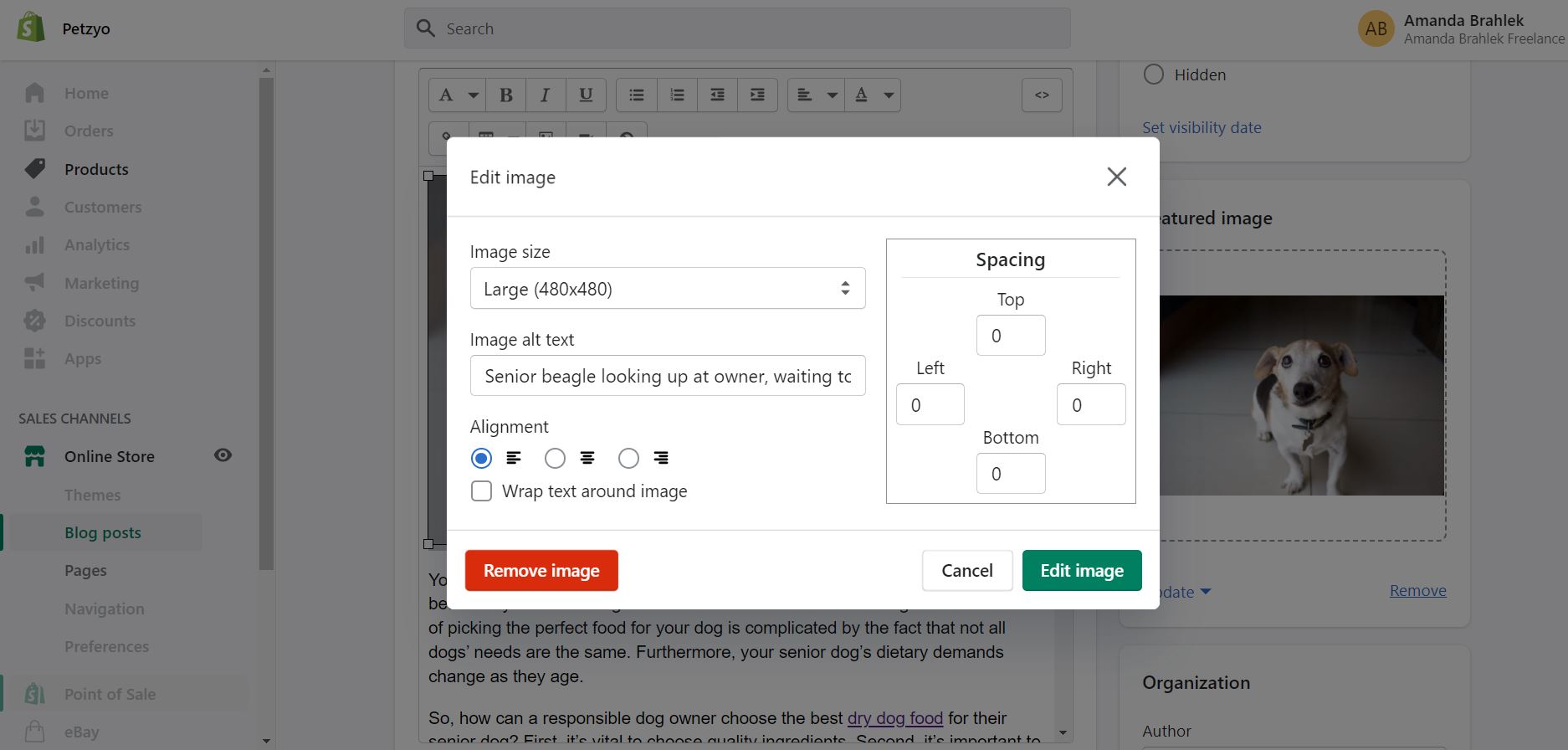 Screenshot from Shopify, January 2022
Screenshot from Shopify, January 2022
This also makes your Shopify website more accessible to users with visual impairments.
10. Create Blog Content To Target Long-Tail Queries
To capture users who are near the top of the sales funnel, create high-quality blog content that is optimized for relevant long-tail queries.
-
 Screenshot from Shopify, January 2022
Screenshot from Shopify, January 2022
By answering the questions users are asking about products like yours, you can build brand awareness and expertise.
It’s also a great way to increase the total number of keywords that your Shopify store ranks for.
Technical SEO
11. Create An SEO-Friendly Navigation Menu
Navigation menus help your users easily move throughout your online store. Not only will a SEO-friendly navigation menu look better to Google crawlers, but it will also create a better user experience.
-
 Screenshot from Shopify, January 2022
Screenshot from Shopify, January 2022
A few SEO tips for navigation:
- Prioritize clear and easy navigation.
- Take the time to make sure that your products are well organized into collections.
- Keep your navigation consistent across the page.
- Use the nav to help users easily contact you or your support team.
12. Leverage Internal Links
Your internal links accomplish a few things.
They keep users moving throughout your website, they help search engine crawlers understand your site architecture, and they distribute your PageRank across more of your site.
The majority of your Shopify website’s PageRank will be on your homepage, which is why the links you include in your nav menu should be strategic.
-
 Screenshot from macaronqueen.com, January 2022
Screenshot from macaronqueen.com, January 2022
Avoid sending link equity to items that are out-of-stock, seasonal, or are unlikely to rank well in search results due to thin or unoptimized content.
Instead, push PageRank toward pages that you want to elevate in search, like your primary category and collection pages.
13. Add The Products Schema
There are a few different ways to add structured data to your Shopify website, and which is best for you will be determined by how comfortable you are editing your website’s code. To add schema manually, go to Themes > Action > Edit Code.
You can use a schema generator tool to generate your markup and input all of the required properties.
Shopify users should consider using the following Product Schemas when applicable:
- Aggregate rating.
- Brand.
- Category.
- Color.
- Dimensions.
- Model.
- Material.
- Special offers.
- Image.
If working in your HTML editor isn’t your jam, plenty of Shopify plugins have Products schema features and make the process simple.
14. Add Product Reviews
Positive reviews on your products can push users toward a click or purchase.
Download the Product Reviews app in the Shopify store to start leveraging product reviews. This app sends structured data information to Google so those yellow stars appear with your SERP result.
-
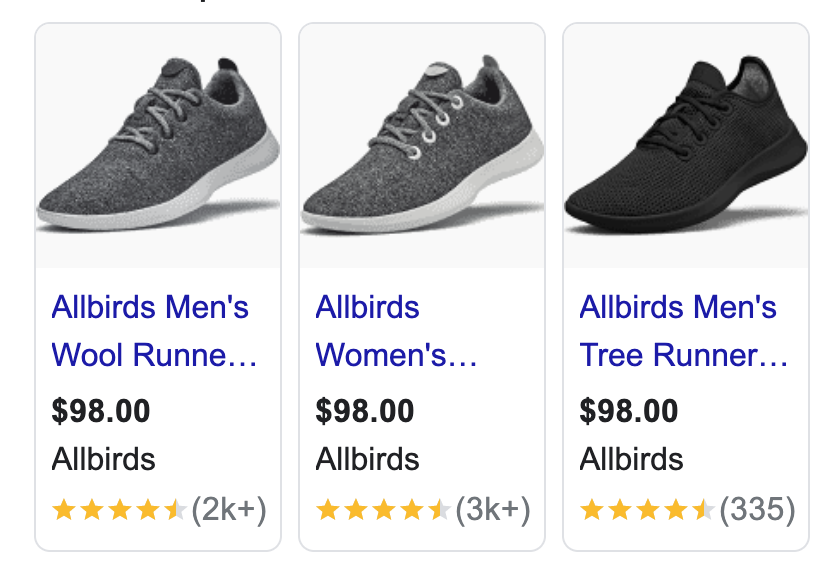 Screenshot from Google, January 2022
Screenshot from Google, January 2022
They can be game-changing in improving CTRs and generating more clicks to your store.
Off-Page SEO
15. Build Links To Your Shopify Site
You will also need to build off-site signals in order for Google to trust your online store and rank it in search results.
This is arguably the most difficult part of SEO because you don’t have control over whether a website chooses to link to yours.
However, there are some easy ways to start earning links:
- Create high-quality content like blog posts and ask other site owners to link to it.
- Get featured in gift guides or product roundups.
- Guest blog on relevant sites.
16. Invest In Public Relations
Public relations and organic outreach are at the heart of link building and one of the best ways to earn high-quality links from authoritative websites.
If you don’t yet have the time or resources to do PR outreach, sign up for Help-A-Reporter Out (HARO). You’ll get daily emails from journalists and publishers looking to hear from experts or feature certain products.
Shopify Website Maintenance
17. Regularly Audit Your Website
Over time, your website will change. This occurs as you add or delete pages on your website, as your pages accrue backlinks, or as the landscape of search changes.
A regular website audit can help you determine which of your pages are performing the best in search and which are underperforming.
The insights provided from a website audit can help you identify key content, page experience, or authority issues that you need to prioritize and resolve.
18. Repair Broken Links
As you change up your product offering or items go out of stock, you will likely unpublish or delete pages of your Shopify Website.
If that page was linked to anywhere else on your website, you will create a “broken link.”
Google does not like to rank websites with excessive broken links, as it looks as if the website is not active and being properly taken care of.
Once a quarter, it’s a good idea to run a site crawler across the entirety of your website to identify broken links and repair them.
19. Study The Data And Iterate
As more users visit your online store, your analytics tools will provide you with loads of data about how they are behaving on your website, how they got there in the first place, and more.
Make sure to draw insights from that data to iterate on your keyword targeting, page content, internal linking, meta tags, and more.
Conclusion
Remember, SEO has a wonderful way of lowering customer-acquisition costs in the long term.
Learning the basics of Shopify SEO and taking the necessary steps can be all the difference in outranking and outperforming your competitors.
Follow the checklist above, and you’ll most likely see Google reward you with more keyword rankings and more site traffic.
More resources:
Featured Image: Kaspars Grinvalds/Shutterstock
